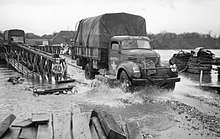Canadian Military Pattern truck
Canadian Military Pattern (CMP) trucks were a class and a coherent range of military trucks, made in large numbers, and in numerous variants, by Canada during World War II, compliant to British Army specifications, primarily intended for use in the armies of the British Commonwealth allies, but also serving in other units of the British Empire.
| Ford F15 | |
|---|---|
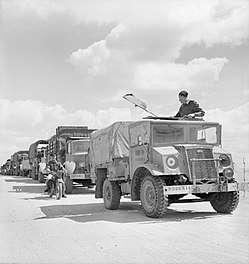 A Ford F15 (4x2) leading an RAF convoy in North Africa | |
| Type | 3 ton 4x4 Cargo |
| Place of origin | General Motors of Canada Limited Ford and Chrysler Canada |
| Service history | |
| In service | From 1940 |
| Wars | World War II |
| Production history | |
| Designer | General Motors Canada and Ford |
| Designed | 1936–1940 |
| Manufacturer | Chevrolet in Oshawa and Ford |
| Produced | 1940–1945 |
| No. built | 500,000+ Service Flag 3298 for Employees of Canada's Armed Forces |
| Specifications | |
| Mass | 7,875 lb (3,572 kg) |
| Length | 204 in (5.18 m) |
| Width | 84 in (2.13 m) |
| Height | 116 in (2.95 m) |
| Engine | Chevrolet GM 216 216 cu in (3.5 L) petrol I6 85 hp (63 kW) Ford 239239 cu in (3.9 L) petrol V8 95 hp (71 kW) |
| Suspension | Wheel 4x4 |
| Maximum speed | 50 mph (80 km/h) |

Until the currency restrictions of the late 1940s, the Canadian automotive industry's output provided a major part of British Empire countries vehicles. These territories levied reduced, Imperial preference, duties on Canadian products, usually made by Canadian subsidiaries of the big U.S. auto manufacturers. In the late 1930s, Canada started drawing up standard designs, to prepare for the beginning of the war, which involved a unique and historic design and production collaboration between rival giant car-makers Ford and GM of Canada.
Canadian Military Pattern trucks not only motorized the militaries of Britain, Canada, Australia and New Zealand, but were also sent to the Soviet Union following the Nazi invasion, as part of Canada's Gift and Mutual Aid program to the Allies.
During the War, CMP trucks saw service around the world in the North African Campaign, the Allied invasion of Sicily, the Italian Campaign, the Soviet Front, the Burma Campaign, the Battle of the Philippines (1941–42), the liberation of Northwest Europe, and the Western Allied invasion of Germany. CMP trucks also served in post-war conflicts in Indonesia, French Indochina, and the Portuguese colonies in Africa.
The United Kingdom's official History of the Second World War called Canada's war-time production of soft-skinned trucks, including the CMP class, the country's most important contribution to Allied victory.[1] Canada's trucks are considered to have "..put the British Army on wheels" — in the North African Campaign, the British Eighth Army fought Rommel using almost exclusively CMP trucks; and the Allied progress from Sicily, through Italy and France, depended heavily on the Canadian trucks.[2][3] By war's end, Canada's vast supply of trucks provided a vehicle for every three soldiers in the field — compared to one vehicle per seven American GIs, making it the most mobile army in the world.[3]
History
The rise to power in Germany of Hitler and the Nazi party in 1933 led to discussions in the mid-1930s between the British War Office and the Canadian Army concerning the possible production of military vehicles in Canada. During the First World War Canadian land forces had participated as a corps in the British Army. In any future conflict it was assumed that Canadian forces would again be tightly integrated with those of the Mother Country, and so it would be essential that Canadian-manufactured equipment be compatible with British standards and specifications.
Early in 1937, the Ford Motor Company of Canada and R. S. McLaughlin of General Motors of Canada Ltd were each invited by the Canadian Department of National Defence to produce a Canadian prototype of a 15-hundredweight (cwt), (similar to ¾-ton U.S.) payload rating, light infantry truck that had then been recently adopted by the British War Office.[4] By 1938, Canadian military authorities had shifted their interest to heavier 4x4 and 6x4 designs. In that year, Ford and General Motors of Canada Limited were invited to produce prototypes of a 6x4 medium artillery tractor derived from the British 6x4 Scammell Pioneer. By 1939, plans had been prepared for the mass production in Canada of a range of military vehicles based on fairly strict CMP British specifications. These trucks were originally designated "Department of National Defence (DND) Pattern"; however, when production volumes increased and it became clear that the Canadian-built vehicles were to serve widely in the forces of other countries, the class of trucks was redesignated "Canadian Military Pattern (CMP)". At the outbreak of World War II, Canada's large and modern automobile industry was shifted over to the production of military vehicles outproducing Germany.
Initially intended for Canadian military use, the vehicles were soon taken on by all British and Commonwealth forces. While the Dunkirk evacuation in the spring of 1940 succeeded in rescuing close to 340,000 Allied soldiers who had been encircled by the invading German army, the British Expeditionary Force had been required to abandon most of its military vehicles in France. It then became an urgent need to replace those losses and to provide new vehicles to equip the rapidly expanding armed forces of the Commonwealth. CMP vehicles, based on the British specification and with large manufacturing capacity, were the logical answer.
Production
Canadian factories produced around 850,000 vehicles in World War II, including some 50,000 armoured vehicles, self-propelled guns and tanks.[3][5] But the greatest significance had the vast majority – more than 800,000 units — of trucks and light wheeled vehicles, produced by Ford, General Motors and Chrysler of Canada.[2][6] Thanks to a large pre-war automotive sector, Canada's great wartime achievement was to build more military trucks than the main Axis nations — Germany, Italy and Japan — combined, matching the demands of mobile warfare in the age of Blitzkrieg.[3]
Canada's military truck production focused predominantly on a broad range of medium-rated vehicles — light jeeps and trucks over 3-tons capacity, required by the Canadian Army, were purchased from outside suppliers.[7] Canadian industry production included both modified civilian / commercial designs (306,000 of which were classified as Modified Conventional Pattern, or MCP),[5] as well as dedicated military-purpose designs, conforming to the Canadian Military Pattern specification, in roughly equal numbers.
Most CMP trucks were manufactured by the Canadian Chevrolet division of General Motors, and Ford Motor Company of Canada. The two manufacturers were able to quickly ramp up their Canadian production, by utilizing their large amounts of reserve production capacity that had remained idle ever since the Great Depression, and through an unusual act of collaboration between the two rival companies, including the use of interchangeable components. A smaller number of CMP trucks were assembled from Canadian-made chassis and parts, typically first built on Canadian production lines, then broken (knocked) down, crated, and shipped overseas, and then to be re-assembled in Britain, Australia, New Zealand, South Africa (2,600), India (9,500), Italy and Egypt.[3] Following British convention, CMP trucks had right-hand drive even though most of them were built in Canada, which primarily used left-hand drive vehicles. The CMP specification proved versatile, and it formed the basis of a wide variety of different truck types and even some armoured vehicles. Encompassing a bewildering variety, there were no less than ninety types of CMP army vehicles, on twelve different chassis, including three different types of wireless trucks, four ambulance types, and thirteen field workshop vehicles.[2] In Australian service (almost always with the No. 13 cab), these vehicles were known as the "Chev Blitz" or the "Ford Blitz".
Around 410,000 CMP trucks were manufactured in Canada,[5][8] with GM contributing 201,000 and Ford making the remainder.[6] The most prevalent models were 4x4, 3-ton trucks (common types were the Chevrolet C60S and C60L, and the equivalent Ford F60S and F60L), with just over 209,000 vehicles made. Additionally, Chrysler was enlisted to crank out another 180,000 Dodge trucks, just over three quarters of which were 3-ton trucks to also be used in the CMP role,[2] — although these conformed to the CMP pattern to a clearly lesser extent, fitted with standard Dodge control cabins, riding on two inch longer wheelbases, and most only had two-wheel drive.
Furthermore, roughly 9,500 4x4 CMP chassis were made, mainly to be used to build armoured cars and other vehicles in Allied countries.
Canada's production of CMP trucks alone exceeded the total military truck production of Nazi Germany. The British History of the Second World War (the United Kingdom's official account of the war) argues that the production of soft-skinned trucks, including the CMP truck class, was Canada's most important contribution to the eventual Allied victory.[1]
After 1945, newly manufactured, as well as modified war surplus, CMP trucks were used in several European armies (e.g., the Netherlands, Belgium, Denmark, Norway, Portugal, Spain), and around the world (e.g., South Africa, Argentina, Jordan, South Vietnam, Malaya). CMP trucks were adapted after the war for a variety of civilian roles including forestry, grain transport, fire-fighting trucks, and snowploughs. In Malaysia, after the Malayan Emergency, many CMP trucks were converted to log transporters or off-road trucks in construction site with upgraded brake system and powerful engines.
Canadian Military Pattern types
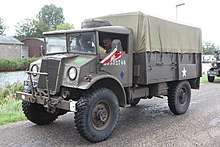
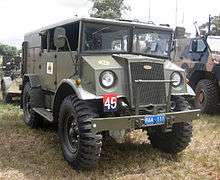
The Ford-built CMP trucks used a 95 bhp (71 kW), 239 cu in (3.9 L) Ford V8 Flathead engine while most of the Chevrolet-built CMP trucks had a 216 cu in (3.5 L), 85 bhp (63 kW) straight-6 overhead-valve engine. An American-made 270 cu in (4.4 L) GMC straight-6 engine powered the C60X 3-ton truck.
The Ford and Chevrolet trucks shared a standard cab design, which evolved over the years of production. The first (designed at Ford by Sid Swallow), second and third cab designs were called No. 11, 12 and 13, respectively. The first two type were similar, the main difference being a two-part radiator grille in No.12 cab (its upper part was opened with a bonnet, which was known as the "Alligator cab"). The final No. 13 cab, an entirely Canadian design made from late 1941 until the end of the war, had the two flat panes of the windscreen angled slightly downward to minimize the glare from the sun and to avoid causing strong reflections that would be observable from aircraft.
All the CMP cab designs had a short, "cab forward" configuration that gave CMP trucks their distinctive pug-nosed profile. This design was required to meet the original British specifications for a compact truck design that would be more efficient to transport by ship. The specifications also demanded right-hand drive.
Internally the cab had to accommodate the comparatively large North American engines and it was generally cramped.[9] The standard cabs were then matched up with a variety of standard chassis, drive trains and body designs. Chevrolet-built vehicles could be recognised by the radiator grille mesh being of a diamond pattern, whereas Ford-built ones had grilles formed of a square mesh.
Dodge production started later. Early prototypes used the No. 13 cab, but production vehicles retained a commercial cab and longer conventional control similar to MCP vehicles. This enabled more rapid production, while retaining similar specifications for chassis, drive, and mounting of vehicle rear bodies.
The production of CMP truck bodies in Canada was subcontracted out to smaller companies in Ontario and Manitoba, organized into the wartime "Steel Body Manufacturers Association" by the Department of Munitions and Supply.[10] The dizzying variety of truck body designs included general service (GS) / troop carrier, fuel / water tanker, vehicle recovery (tow truck), field ambulance, dental clinic, mobile laundry, wireless house (radio HQ), machinery (machine shop / welding station), folding boat transport, artillery tractor, and anti-tank gun portee.[3]
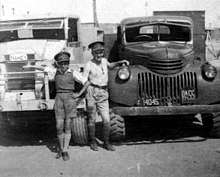
In the list below, a drive specification of NxM means that the vehicle has a total of N wheels and that M of those wheels are driven. The military specifications did not permit more than two wheels per axle.[nb 1] The British standard load capacities of 8 cwt (hundredweight), 15 cwt, 30 cwt and 60 cwt correspond roughly to the American loads of 1/2 short ton, 3/4 ton, 1.5 ton and 3 ton, respectively. The 60-cwt CMP trucks were usually called 3-ton lorries or trucks.
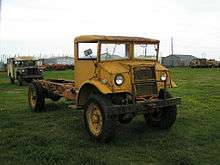
Chevrolet, General Motors
- Chevrolet C8 (4x2, 101-inch wheelbase, 8 cwt)
- Chevrolet C8A Heavy Utility Truck (4x4, 101 inch wheelbase, 8 cwt)
Made in Wireless (HUW), Ambulance (HUA), Personnel (HUP), Machinery ZL (mobile radio repair shop) and Computer (accounting, payroll) configurations - Chevrolet C15 (4x2, 101-inch wheelbase, 15 cwt)
- Chevrolet C15A (4x4, 101-inch wheelbase, 15 cwt)

- Chevrolet C15TA Armoured Truck (4x4, 101 inch wheelbase, 15 cwt)
- Chevrolet C30 (4x4, 134 inch wheelbase, 30 cwt)
- Chevrolet C60S (4x4, 134 inch wheelbase, 3 ton)
- Chevrolet C60L (4x4, 158 inch wheelbase, 3 ton)
- Chevrolet C60X - C60 chassis with 6x6 drive, 160 inch +52 inch wheelbase, 3 ton, 270 cu. in. GMC straight-6 engine)
- Chevrolet CGT Field Artillery tractor (4x4, 101 inch wheelbase)
- General Motors Fox armoured car (4x4, 101 inch wheelbase) - based on the Humber Armoured Car
- General Motors Otter Light Reconnaissance Car (4x4, 101 inch wheelbase)
Ford
- Ford F8 (4x2, 101 in (2.6 m) wheelbase, 8 cwt)
- Ford F15 (4x2, 101 inch wheelbase, 15 cwt)
- Ford F15A (4x4, 101 inch wheelbase, 15 cwt)
- Ford F30 (4x4 drive, 134.25 inch wheelbase, 30 cwt)
- Ford F60S - 4x4, "short" 115 inch wheelbase, 3 ton)
- Ford F60L - 4x4, "long" 158.25 in (4.020 m) wheelbase, 3 ton
- Ford F60T tractor unit (4x4, 115 inch wheelbase, 3 ton)
- Ford F60H - 6x4, rear axle undriven, 160.25 inch +52 inch wheelbase, 3 ton
- Ford FGT Field artillery tractor (4x4, 101.25 inch wheelbase)
- Ford Lynx Scout Car (4x4, 101 inch wheelbase) - based on Daimler Dingo
Dodge trucks
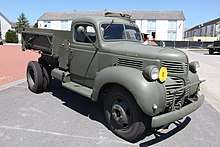
Though popular sources on Canadian Military Pattern trucks mainly discuss the Ford and GM models, Dodge built some 180,000 trucks, most of which for use in the CMP role,[2][11] and by the same naming convention — three quarters of which were 3-ton models of various D60 (Dodge T-110) types.[12][nb 2]
To achieve a quick increase in output of trucks that provided equal functionality, it was deemed acceptable for the Dodges to forgo the standardized Ford and Chevy control cabin; and like the other two automakers, Dodge equally fitted its own engines. But although regular Dodge cabs were fitted, they were right hand drive,[nb 3] and had a gunner's hatch in the roof. After initial D60s had been produced with 8.25x20 tires and dual rear wheels, they were subsequently switched over to the larger, CMP specification 10.50x16 size, and axles with single rear wheels, as well as being fitted with British design rear bodies. Operator's and technical manuals for the Dodges also mirrored the Ford and GM CMP manuals. This notwithstanding, all of Dodge's models were two-wheel drive, with a high and low-range rear axle. All Dodges were powered by Chrysler's straight-six flathead gasoline engines — the 3-ton D60 models' 236 cu in (3,870 cm3) delivered 95 HP @ 3600 rpm.[11]
- Dodge D8A (8cwt, or ½-ton – engineering code T-212)
- Dodge D15 (15cwt, or ¾-ton – engineering code T-222)
- Dodge D60S (60cwt, or 3-ton, engineering code T-110L-6, with a short 136" wheelbase)
- Dodge D60S/DD (60cwt, or 3-ton, engineering code T-110L-13, with a short 136" wheelbase)[13]
- Dodge D60L (60cwt, or 3-ton, engineering code T-110L-5, with a long 160" wheelbase)
- Dodge D60L/D (60cwt, or 3-ton, engineering code T-110L-9, with a long 160" wheelbase)[13]
- Dodge D60L/DD (60cwt, or 3-ton, engineering code T-110L-12, with a long 160" wheelbase)[13]
The initial 60cwt, or 3-ton Dodge types: the T110L-S, T110L-3, T110L-4, as well as the later T110L-14 didn't formally carry a D60 nomenclature.[13][nb 4]
Outside Canada
Chassis and vehicle production was licensed to Australia, allowing local production, while other vehicles were shipped to Britain in part-assembled "knocked down" form. These were delivered as kits, and had final assembly in factories in Britain. Air portable versions had the top half of the cab superstructure and exterior components stowed to allow the vehicles to fit in the hold of transport aircraft, which could easily be re-fitted on receipt in theatre.
Bare chassis were created for alternative bodies to be fitted, reducing the shipping requirement to India. Bodies for these vehicles were locally produced in India from available materials, frequently built entirely from wood, creating a diverse range of "Indian Pattern" vehicles.
To meet the pressing demand for military vehicles during World War II, several Commonwealth countries designed light armoured vehicles based on CMP chassis made in Canada. Special chassis were created to aid in this purpose, featuring rear mounted engines and central steering positions. Armoured cars used these or standard chassis depending on design and availability.
- Ruskin Motor Bodies Pty Ltd and Ford Motor Company of Australia Rover Light Armoured Car (4x4, 134.25-inch and 158.25-inch wheelbases) - built on Ford 3-ton CMP chassis
- General Motors Holden Ltd Rhino Heavy Armoured Car (4x4, 101-inch wheelbase) - prototype only
- General Motors Holden Ltd 6x6 Heavy Armoured Car (6x6, 158-inch wheelbase)
- Indian Railways Armoured Carrier Wheeled Indian Pattern (ACV-IP) (4x4, 101"? wheelbase) - most used CMP chassis
- South African Reconnaissance Car, also called the Marmon-Herrington Armoured Car (4x4, various wheelbases)
- Beaverette NZ, the New Zealand version of the British Standard Beaverette armoured car
- C8AX "Puddlejumper" (4x4, 101-inch wheelbase, 8 cwt), variant created in New Zealand based on the C8A chassis
A number of Indian Pattern vehicles also had armoured bodies built, creating armoured trucks.
See also
- List of military equipment of the Canadian Army during the Second World War
- CMP FAT
- Morris C8 Field Artillery Tractor
- Military history of Canada during the Second World War
Footnotes
- This restriction could have several possible benefits. First, a standard axle length would simplify the use of standard loading ramps, partial bridge decks, and bridge decks in which the road bearing girders protrude above the road surface on the top side. Second, the load of trucks of a standard axle length is more directly and safely transmitted down to the longitudinal spans supporting the bridge under the bridge deck by positioning the spans apart to match the standard axle length. Third, allowing only one wheel at each end of an axle would ensure that all wheels would be fast to change. Finally, minimizing the tread width would very slightly reduce a vehicle's vulnerability in minefields while following other vehicles of the same standard axle length.
- Chrysler's internal annual publication of starting and ending serials of all models shows production of 137,127 three-ton T-110 (or D60) variants:[12][13]
T110L-S (3-ton SWB) – 1,500 units
T110L-3 (3-ton LWB) – 3,000 units
T110L-4 (3-ton LWB) – 3,000 units
T110L-5 (D60L) – 80,384 units
T110L-6 (D60S) – 11,670 units
T110L-9 (D60L/D) – 15,539 units
T110L-12 (D60L/DD) – 11,690 units
T110L-13 (D60S/DD) – 5,678 units
T110L-14 (3-ton LWB) – 4,666 units
Plus an additional 43,618 other models:
T212 (D8A) – 3,002 units
T222 (D15) – 28,866 units
T236 (3/4APT – Canadian WC-52s) – 11,750 units
Adding up to a total of 180,745 trucks. - Except for Canadian domestic use units.[11]
- Initial units came with smaller wheels and tires, and dual rear wheels.[11]
References
- Notes
- Hall, H. Duncan and Wrigley, C. C. Studies of Overseas Supply, a volume in the War Production Series directed by M. M. Postan, published as part of the History of the Second World War. United Kingdom Civil Series edited by Sir Keith Hancock. Her Majesty's Stationery Office and Longmans, Green and Co., London, 1956, pp. 51-52.
- Granatstein, Jack (27 May 2005). Arming the Nation: Canada's Industrial War Effort 1939–1945 (PDF) (Report). Canadian Council of Chief Executives. p. 12. Archived (PDF) from the original on 2017-12-13. Retrieved 2018-03-06.
- Taylor, Peter Shawn (19 April 2016). "The Trucks that Beat Hitler". National Post. Postmedia Network. Retrieved 2018-05-09.
- Blueprint for Victory..
- Winnington-Ball, Geoff (10 March 2002). "CMP Softskin Trucks". Maple Leaf Up.net. Retrieved 2018-05-09.
- General Motors of Canada – US Auto Industry in World War Two
- Blueprint for Victory..
- Stubblebine, David. "CMP Primary Role Transport". World War II Database. Lava Development, LLC. LCCN 2011214255. Retrieved 2018-05-09.
- Fletcher, David British Military Transport 1829–1956 London 1998 HMSO
- Blueprint for Victory..
- Vanderveen, Bart (1972). "British Commonwealth - Trucks, 3-Ton, 4x2". Observer's Fighting Vehicle Directory, WW II. London: F. Warne. p. 236. ISBN 978-0723214694. Archived from the original on 2018-03-03.
- Wilson, Gerald. "1928-1957 Chrysler, Dodge, Plymouth, Fargo, and DeSoto Car, Truck, and Military Vehicle Model Data Guide". Allpar. VerticalScope Inc. Archived from the original on 2017-06-18. Retrieved 2018-05-21.
Car Serial Numbers in Numerical Sequence (tables)
- Dodge Manual page listing of model codes
- Bibliography
- Gregg, William, (ed.), Blueprint for Victory: The story of military vehicle design and production in Canada from 1937–45, The Canadian Military Historical Society, Rockwood, Ontario, 1981, ISBN 0-9690943-2-9.
- Ware, Pat (2010). The World Encyclopedia of Military Vehicles. Lorenz Books. pp. 108–109. ISBN 0-7548-2052-1.
External links
| Wikimedia Commons has media related to CMP trucks. |
